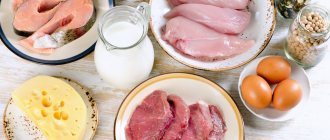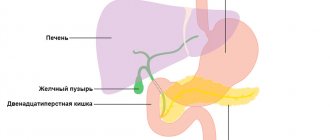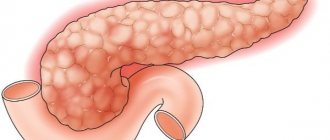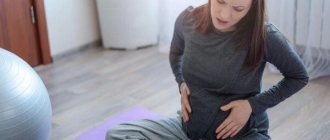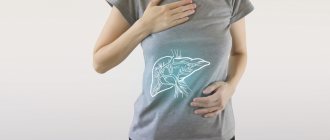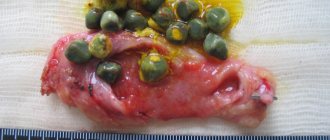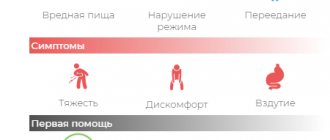Author
Anna Shelestun
Checked by an expert
Tatyana Eliseeva
There are many conditions that can lead to cholestasis - stagnation and reduction of bile flow. In this case, the digestive fluid does not enter the small intestine, does not break down fats and does not remove toxins from the body. This leads to digestive problems and accumulation of toxins. Many factors can trigger the disease, but poor diet and unhealthy lifestyle are the main reasons. Fortunately, illness can be avoided if you adjust your diet in a timely manner.
Why does the body need bile?
The greenish-yellow liquid mainly consists of cholesterol, bile acids and bilirubin, a breakdown product of hemoglobin. Also contains water, salts (potassium, sodium), copper and other metals. [1] It is the main antiseptic in the body and performs many functions:
- removes toxins into stool to prevent toxic overload;
- stimulates the secretion of water in the large intestine, improves motility and prevents constipation;
- distributes antioxidants and immunoglobulins throughout the intestines;
- has an antimicrobial function and prevents the development of dysbacteriosis;
- neutralizes stomach acid for the functioning of pancreatic enzymes.
If these processes are disrupted, there is a constant feeling of fatigue, a white or yellow coating on the tongue, bad breath, cravings for sugar and excess weight gain in the abdominal area. [2, 3] The problem cannot be ignored, because disorders can lead to dangerous liver pathologies, especially if biliary dyskinesia is diagnosed. You need to start with changing your diet - even doctors admit that a proper diet is often more effective than medications. [4]
Bile flow sequence
- the liver produces 500–600 ml of bile daily;
- half of the fluid excreted between meals enters the small intestine;
- the rest is diverted to the gallbladder for storage, where 90% of its water is absorbed into the bloodstream - this makes the reserves very concentrated;
- when food with fats enters the small intestine, a series of hormonal and nervous signals causes the bile duct to contract and the sphincter of Oddi to relax and open so that bile flows to the food and performs digestive functions;
- about 90% of bile acids are reabsorbed into the bloodstream through the walls of the small intestine, after which the liver removes them from the blood and re-releases them into bile - the components go through this cycle 10-12 times a day;
- a small amount of acid reaches the colon, where it is broken down by bacteria - some is reabsorbed, and some is excreted in the stool, giving it a dark color. [5]
Causes of stones
When a lot of cholesterol begins to accumulate in the bile, the disease gradually begins to develop. A large accumulation of cholesterol can result from:
- obesity;
- frequent consumption of fatty foods;
- stagnation of bile.
Bile stagnation can be functional or mechanical. In the latter case, the pathology can be caused by:
- tumor;
- an increase in the size of neighboring organs;
- the appearance of scars;
- inflammatory reactions leading to swelling of the walls of the organ.
Stages of gallstone disease
Gallstone disease has several stages:
- Pre-stone (also called physicochemical). It is the initial stage at which the first changes occurring in the composition of bile are noted. There are no special or obvious symptoms. The development of the disease can only be determined using a biochemical examination.
- Hidden form. At this stage, stones are just beginning to appear. There is also no clear clinical picture. The presence of pathology can be determined using instrumental diagnostic procedures.
- More severe stage. Symptoms of the disease begin to appear.
Types of stones
Stones may differ in their chemical composition. Depending on this they are:
- Bilirubin. Bilirubin is a product formed as a result of the breakdown of hemoglobin. They are relatively small (up to 1 cm), but can be present in considerable quantities.
- Cholesterol. Despite the fact that cholesterol is present in bile, if it accumulates excessively, stones will appear. This component is ingested along with consumed products. When the process of its absorption is difficult, it begins to accumulate and turn into stones. They usually have an oval or round shape, not exceeding 1.5 cm in diameter.
To size:
- Small ones. They reach 3 cm in diameter.
- Big ones. They reach more than 3 cm in diameter. They impede the outflow of bile, which is why attacks often occur.
Is the flow of bile disrupted or not? Test yourself
“Man’s bile is like gold. There should be so much of it that, like gold, it can cover all the expenses of the human condition. If there is much more of it in the body than is needed, it (bile) will depreciate. If there is less of it than needed, it will be like gold in complete famine. Then you can’t buy food with it to survive…” - this is how the ancient Tibetan healers Emchi assessed the role of bile in the human body.
The gallbladder system is more than the storage and elimination of bile.
Eastern medicine traditionally considers the gallbladder and the state of bile in it in the context of its systemic energy value for humans. The gallbladder system is closely connected with the liver system as an organ that produces bile. Practical medicine of Tibet, China, India and other Eastern countries traditionally attaches great importance to the gallbladder as an energy system, respectively, in a broader form and volume than the anatomical - physiological function of this organ, which consists in the accumulation and excretion of bile.
Where is the main source of courage?
Since antediluvian times, Eastern physicians have considered the gallbladder system, together with the liver system, as “the main source of courage, determination, and, in the presence of obstacles, as a source of aggressiveness, hostility and anger.” With various manifestations of “functional failure” of the gallbladder, pathological manifestations occur.
A wide range of emotions, experiences, and behavioral characteristics can significantly distort and even have a destructive effect on the energy system of the gallbladder . It should be noted that it is the gallbladder, as a “system of activity and anger,” that can keep the entire human body in tension. Accordingly, this leads to stagnation of bile in the gallbladder , forming signs of excess energy, the so-called symptoms of “yang” .
As a rule, such symptoms lead to spasms of the bronchi with the subsequent development of bronchial asthma, to spasms of the main coronary vessels with the subsequent development of angina pectoris. The spastic state of the cerebral vessels is primarily associated with the state of excess energy in the gallbladder.
Revelations of Sole-De Moran from time immemorial.
One of the greatest apologists of oriental medicine, the Frenchman Sole-De Moran, wrote in his famous book “Ten Thousand Steps to the Top of the Mountain”: “We can safely say that, having only mastered the diagnosis and treatment of the gallbladder system (channel), you can safely take on such difficulties such as diseases of the skin, sexual sphere, joint diseases of the legs, especially the hip joints, bone pain in the lower extremities in general and pain in the bones of the feet in particular. And of course - these are all types of colds with their own peak - enfluenza (flu)."
4 main conditions for the functioning of the digestive systems.
Oriental doctors absolutely rightly believed that the quality of the digestive systems, which includes the gallbladder system, is primarily influenced by the main 4 living conditions. These are the person’s age, the quality of the current season, state of mind and nutrition. Wise Tibetan emchis like to repeat: “it is impossible to eat and drink for future use because you cannot store up bile for future use.” Fear the bile of young and old. Young as skimmed milk, you won’t live long with her. And the old one is like butter. You won’t be as full of them alone.”
Signs of impaired bile flow.
It is very important that the general symptoms of trouble in the gallbladder system are very clear and noticeable and have such manifestations as a pale, sallow face, bitterness in the mouth, pain in the right hypochondrium, pain in the right side, pain in the heart immediately after eating, pain and a feeling of constriction head and chin, the so-called “bilious hoop”, hot feet, so-called peritoneal chills, fetid sweating, swollen glands under the arms, tension in the back of the neck muscles, cervical lumbago, pain in the outer surfaces of the thighs, knee joints, outer ankles.
Symptoms of excess energy in the gallbladder system— yang symptoms— include:
Feeling of fullness in the stomach, heaviness in the head, pain on the outer thighs (strap zone), hot skin of the neck both in front and behind, night terrors, bitterness in the mouth, nausea, swelling of the neck, cheeks, chin, frequent throat diseases, difficulty falling asleep from 23 to 1 am, hot feet from 11 to 13 pm, periodic vomiting of bile on a lean stomach.
Symptoms of a deficiency in the gallbladder system— yin—symptoms include:
General loss of strength, weakness, dizziness, heavy deep sighs, unsteady (drunk) gait, the skin of the face and neck above the line of the collarbones is pale and cold, shortness of breath at rest, swelling of the feet and popliteal fossa without leaving traces of pressure, frequent inflammation of the upper and lower eyelids, jaundice of the sclera (yellow coloring of the surface of the eyeball), daytime drowsiness, night sweats.
What does this mean?
Disorders in the gallbladder system of the “yang” type - symptoms lead to the development of the following diseases:
Gastritis, gastroduodenitis, duodenopancreatitis, in childhood and adolescence lead to the development of hyperactivity syndrome, impaired psycho-emotional stability, cardioneurosis, asthenovegetative symptoms, a wide range of skin suffering (neurodermatitis, eczema, psoriasis, seasonal furunculosis, extensive juvenile acne), etc. Development " “yang” symptoms are indirect causes of disorders in the human sexual sphere and manifest themselves in early puberty, which is fraught with such manifestations as uncontrolled masturbation, and can also lead to the development of varicocele in boys and polycystic adnexa in girls.
Disorders in the gallbladder system of the “yin” type - symptoms lead to the development of diseases and functional disorders such as:
Dyskinesia of the bile ducts, extrahepatic cholangitis, cholelithiasis, cholecystitis, reflex osteochondrosis of the cervical spine, right - and bilateral cervicalgia. Biliary dyskinesia, in turn, leads to the formation of spastic-atonic colitis, which is fraught with such serious vascular suffering as varicose veins of the lower extremities, phlebitis and thrombophlebitis. Tibetan and Chinese doctors have reliably proven the close relationship between coronary heart disease and “yin” - symptoms in the gallbladder system.
How does modern medicine register a violation of the outflow of bile?
As a rule, modern medicine does not consider these symptoms as the main signs of disorders in the gallbladder, but relies on laboratory and functional diagnostic data (FGS, ultrasound and MRI) when making diagnoses. But such data can only establish the presence of a developed disease, and not its initial phase, much less the cause of its occurrence.
The only method that allows one to reliably identify the cause of the development of “yang” and “yin” symptoms in the gallbladder system is iridoscanning - a method of diagnosing the body by the state of the iris of its eyes.
We, the authors of “Dr. Kartavenko’s School of Safe Health,” have conducted a study of the body using the iridoscanning method of 845 people over the past six months. As a result of the analysis of these studies, we identified the following patterns:
bile outflow disorders accounted for 83.4% of 100% of those examined. Of these, only in 11.8% we noted changes in the gallbladder area on the iris of the eyes, corresponding to signs of hyperactivity of the gallbladder or “yang” symptoms in the gallbladder system, the remaining 71.6% correspond to signs of hypofunction or “yin” symptoms . The reliability of such data was confirmed by the clients themselves as a result of their survey during consultations.
Decide for yourself which path to choose.
And so, dear readers, now you can independently answer the question: “Is your bile flow impaired? And if the answer is affirmative, then what kind of violation exists.” But if you still want to seek the help of specialists, then you have a choice:
Or you go first to a therapist, then a lot of tests (swallow the “gut” during FGS, donate blood on an empty stomach, have an ultrasound done by another specialist, and maybe even an MRI). After two weeks of visiting offices, tiring queues, and hassle in the “You weren’t standing here” format, you will most likely receive an approximate answer. But in order to understand “What should you do with this?”, you need new trips to specialists for a prescription. And when they end with receiving prescriptions, then you are waiting for a search for medicines, alas, consisting of 97% of the chemicals that usually lie on pharmacy shelves and are very unsafe.
Or you examine the body using the iridoscanning method while at home, immediately receive recommendations for your individual safe health and can immediately begin to act.
What would you choose, dear readers? We are waiting for your comments.
We remind you that our wonderful recipe for detox soup “Weight Loss”, which is still freely available, will help you improve and normalize the flow of bile. Enjoy it for your health!
And also, a face-to-face express consultation with Professor V.V. Kartavenko. You can learn more about this and other issues of your personal health at the medical congress “Healthcare of the North Caucasus” in Kislovodsk on April 27 and 28. To do this, you need to call in advance by phone. 8 (863) 2-704-702.
And on April 26 at 12-00 in the same place (3rd floor of the Caucasus Cultural and Exhibition Complex, Shalyapin St., 7) we will hold a seminar for sanatoriums, pharmacies and health centers. For the participants of the seminar, we will conduct a personal consultation: “Look at your organs from the inside,” the cost of which is only 500 rubles, and not 3,700 rubles as usual. Pre-registration is also required for this (tel.. The number of places is limited, so call and make an appointment in advance.
With respect to you and your health, authors of “Dr. Kartavenko’s School of Safe Health” Tatyana and Victor Kartavenko
Signs and symptoms of pathology
Gallstone disease may not make itself felt for quite a long time. In the first stages, it is usually asymptomatic and does not bother the person in any way. When the stones begin to increase in size, the first symptoms will begin to appear, which should alert a person.
The first signs of the development of the disease include:
- feeling of heaviness in the stomach after eating;
- vomiting and nausea;
- slight yellowing of the skin.
Such processes negatively affect the functioning of the gastrointestinal tract.
The most common symptoms include:
- Pain in the right hypochondrium. Seizures occur that can last several minutes or hours. Pain can manifest itself in different ways. If a person does not feel better after 5-6 hours, complications may begin.
- Heat. It is a harbinger of the appearance of a concomitant pathology – cholecystitis. During active inflammatory processes, many harmful substances are released into the blood, which leads to fever. The temperature usually rises to 38 degrees.
- The appearance of jaundice. With prolonged stagnation, jaundice appears. In fair-skinned people, this symptom is more noticeable.
Treatment
Treatment should be comprehensive and include measures to normalize lifestyle, diet and diet, as well as drug therapy. If possible, eliminate physical and emotional stress that negatively affects the motility of the gastrointestinal tract. Long breaks in meals, consumption of fatty, extractive foods, marinades, smoked meats, and coffee are unacceptable. Avoid smoking, drinking alcohol and carbonated drinks. Drug therapy is selected by a gastroenterologist depending on the severity of symptoms and examination results.
Duodenogastric reflux, or the reflux of duodenal contents back into the stomach, is an extremely common digestive disorder. The symptoms that indicate this pathology are subjectively interpreted by many as “heartburn” or “indigestion,” which indicates their low specificity. An accurate diagnosis can only be made by a specialist after a thorough examination. If you experience discomfort associated with eating, we recommend that you contact Professor Gorbakov’s Clinic for specialized help.
Normally, food enters the oral cavity, moves down the esophagus into the stomach, and then enters the duodenum. Here it mixes with bile, which ensures the emulsification (breakdown) of fats and the absorption of most of the nutrients. The unilateral evacuation of food into the duodenum is supported by the reflexive opening and closing of the pyloric sphincter (pylorus). It also prevents retrograde (backward) flow of the bolus.
Improper functioning of the sphincter (its insufficient locking), as well as hypertension in the duodenum associated with chronic duodenitis, can cause bile to flow back into the stomach - duodenogastric reflux.
Often this disorder provokes the presence of inflammatory processes in the stomach (gastritis), duodenum (duodenitis), gallbladder (cholecystitis, biliary dyskinesia), pancreas (pancreatitis), and surgical interventions, namely:
- cholecystectomy;
- gastric resection;
- vagotomy;
- gastroenterostomy;
- enterostomy.
Diagnosis and treatment
If you notice symptoms of the disease, you should immediately consult a doctor. Initially, a physical examination and medical history are prescribed (they are preliminary procedures). Based on the examination, the specialist can refer the patient for certain examinations, namely: blood test (clinical or biochemical), abdominal ultrasound, cholecystography. For maximum clarity, MRI or CT is prescribed.
The disease can be managed using medical and conservative methods. Initially, they resort to therapeutic methods.
- Taking medications. Many doctors prescribe Urolesan.
- Using a shock wave, which will destroy the formed stones. It is created due to the action of special medications. The procedure is practically painless. Stones are passed out of the body during bowel movements.
- Special diet. During the entire treatment course, you should adhere to fractional meals. You need to eat small portions 5-6 times a day. It is worth giving up fried and spicy foods, sweets, and spices. You need to add more dairy and plant products to your diet. Wheat bran is especially useful.
In advanced cases, surgery cannot be avoided.
When choosing a particular treatment method, it is worth taking into account the patient’s age and the presence of other diseases.
Top 15 foods to improve bile flow
Chicken
Steamed, baked or boiled fillets contain lean protein. Dietary protein is valuable because it stimulates the secretion of the hormone cholecystokinin (CCK). It causes contraction of the gallbladder and secretion of pancreatic enzymes.
Radish
Contains sulfur, which helps remove deposits from the gallbladder, and vitamin C to prevent further formation. The composition also contains the enzyme cholesterol-7-alpha-hydroxylase, which reduces cholesterol and triglyceride levels. Despite the benefits, radishes are not recommended for everyone and you should consult your doctor before consuming them. [6]
Broccoli
Cabbage is rich in fiber and calcium, which are essential for gastrointestinal health. Dietary fiber improves peristalsis, microflora, and reduces bile production, which is important when it stagnates. [7]
Coffee
Studies have found that caffeine suppresses the crystallization of cholesterol and increases the outflow of fluid from the gallbladder. However, decaffeinated coffee does not have such effects. [8]
Turmeric
The bright orange spice reduces symptoms of bloating and gas due to indigestion, and has choleretic properties (especially when combined with black pepper). Turmeric, although it improves lipid metabolism, is not recommended for gallstone disease. [9]
Sweet red and green peppers
Bell peppers are the best source of vitamin C among vegetables. It also replenishes B vitamins, magnesium, folic acid and phytonutrients to protect the gastrointestinal tract from many diseases. [10]
Milk thistle
The herb is involved in the formation of enzymes, increases bile production, soothes mucous membranes and reduces inflammation. However, milk thistle is not recommended for Gilbert's syndrome - it accelerates the first phase of detoxification, thereby increasing the level of bilirubin in the blood.
Oranges
The pulp is rich in vitamin C, due to the lack of which gallstone disease develops. This is confirmed by doctors and a year-long study involving 2,129 people. Since taking vitamin C supplements increases the risk of kidney stones, it's best to get the vitamin from natural foods such as oranges and other citrus fruits. [eleven]
Tomatoes
Tomato fruits stimulate bile flow and remove toxins through the digestive tract, and also reduce inflammation. Tomato juice without sweeteners has the same properties.
Salo
The product contains 40% unsaturated fatty acids and is rich in fat-soluble vitamins A, D, E. Therefore, lard binds and removes toxins, and has choleretic properties.
Low-fat dairy products
Low-fat milk, cheese, kefir, yogurt, and yogurt do not burden the gastrointestinal tract, do not delay gastric emptying, and do not cause bloating. Additionally, fermented milk products contain the necessary pre- and probiotics.
Legumes
Beans, soybeans, and lentils are rich in vegetable protein. For problems with gallstones, it is healthier than animals, which is confirmed by research. [12]
Flax-seed
Flaxseed oil reduces pain and has an anti-inflammatory effect. But it cannot be taken for acute pancreatitis (only during remission), since the additional secretion of bile provokes spasms.
Nuts.
Some studies have shown that almonds and walnuts prevent the formation of gallstones. Due to their high fat content, it is important to eat them in small quantities.
Tofu
100 g of vegetarian cheese contains 345 mg of calcium, 8-13 g of protein and only 5-10 g of fat. The dietary product will help avoid attacks of pain in the right hypochondrium, diversify the menu and prevent blockage of the bile ducts.
Other ways to normalize bile flow
The worst enemy of the gallbladder is low-calorie diets and losing weight by 1–1.5 kg per week. They increase the risk of stone formation and other diseases, since when food consumption is reduced, the need for bile decreases - the secretion becomes thick and concentrated. To help your body, you need to follow other rules:
- eat fractionally by the hour - 5-6 times a day at the same time;
- there is a lot of thermally processed and raw fiber; [13]
- avoid fatty foods and consume 20–40 g of fat per day;
- exclude from the diet everything fried, crusty foods and refined carbohydrates - added sugars, sweeteners, white flour, instant cereals, baked goods, desserts;
- give up alcohol;
- do not consume ice cream, cold foods and drinks - the cold blocks the functioning of the organ;
- exclude canned vegetables and fruits from the menu;
- drink 2–2.5 liters of clean water between meals;
- do not get carried away with ginger, as it stimulates the liver to secrete more bile juice, but does not accelerate its release; [14]
- maintain a moderate level of activity - tiring exercise forces the liver to produce bile more actively, but does not improve its outflow. [15]
Expert commentary
Tatyana Eliseeva, nutritionist, nutritionist
Research confirms that bitter foods and bitter herbs—dark green leafy vegetables, beets, artichokes, dandelion root tea, celery juice—help relieve bile flow problems. Discoveries on this matter continue. Thus, in 2022, it was documented that bile acids are produced by microbes in the intestines. This once again confirms that it is necessary to take care of the gastrointestinal tract as a whole, and not about individual organs.
Material publication date – October 20, 2021
Information sources
- Physiology, Bile Secretion, https://www.ncbi.nlm.nih.gov/books/NBK470209/
- Epidemiology of Gallbladder Disease: Cholelithiasis and Cancer, https://www.ncbi.nlm.nih.gov/pmc/articles/PMC3343155/
- Biliary Obstruction, https://www.ncbi.nlm.nih.gov/books/NBK539698/
- Dietary Patterns and Risk of Gallbladder Disease: A Hospital-based Case-Control Study in Adult Women, https://www.ncbi.nlm.nih.gov/pmc/articles/PMC4438647/
- Bile Formation and Secretion, https://www.ncbi.nlm.nih.gov/pmc/articles/PMC4091928/
- Deciphering the Nutraceutical Potential of Raphanus sativus—A Comprehensive Overview, https://www.ncbi.nlm.nih.gov/pmc/articles/PMC6412475/
- Side Streams of Broccoli Leaves: A Climate Smart and Healthy Food Ingredient, https://www.ncbi.nlm.nih.gov/pmc/articles/PMC7178181/
- Coffee Consumption and Risk of Biliary Tract Cancers and Liver Cancer: A Dose–Response Meta-Analysis of Prospective Cohort Studies, https://www.ncbi.nlm.nih.gov/pmc/articles/PMC5622710/
- Effect of black pepper and piperine on bile secretion and composition in rats, https://pubmed.ncbi.nlm.nih.gov/3431580/
- Serum ascorbic acid and other correlates of gallbladder disease among US adults, https://www.ncbi.nlm.nih.gov/pmc/articles/PMC1508320/
- The effect of vitamin C in high doses on plasma and biliary lipid composition in patients with cholesterol gallstones: prolongation of the nucleation time, https://pubmed.ncbi.nlm.nih.gov/9179545/
- Effect of dietary animal and vegetable protein on gallstone formation and biliary constituents in the hamster, https://pubmed.ncbi.nlm.nih.gov/6708746/
- Fruits and vegetables consumption and the risk of gallstone diasease, https://www.ncbi.nlm.nih.gov/pmc/articles/PMC6641782/
- The Effects of Ginger on Gallbladder Motility in Healthy Male Humans, https://www.ncbi.nlm.nih.gov/pmc/articles/PMC3228982/
- Physical Activity Modulating Lipid Metabolism in Gallbladder Diseases, https://www.ncbi.nlm.nih.gov/pmc/articles/PMC8114792/
Attention! The information is for informational purposes only and is not intended to make a diagnosis or prescribe treatment. Always consult a specialized doctor!
Authors: Anna Shelestun, Tatyana Eliseeva Ask a question
Rating:
9.7
/10
Votes: 18
Usefulness of material 9
Reliability of information 10
Formatting of Article 10
